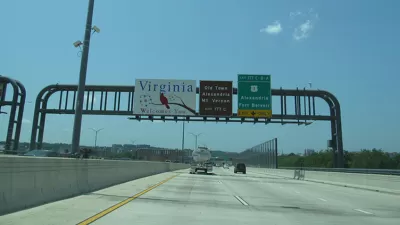Despite installing many innovative traffic management schemes over the years, the 41 miles of highway between Fredericksburg, Virginia and Washington D.C. are snarled by some of the worst traffic in the country. Can HOT lanes change that?
Earl Swift shares the experience of waiting in one of the Beltway’s worst traffic jams: “Of all of Washington's snarled roads, perhaps none are more feared, despised, and lamented than the roughly 41 miles of I-95 between Fredericksburg and the Beltway, and I-395's nine-mile spur from there to the Potomac.”
The traffic persists, although planners have implemented a number of innovative traffic management practices: “In 1969, they installed the first reversible bus lanes in America, on I-395. A few years later they built carpooling in the same lanes — the country's first courtship with high-occupancy vehicle lanes. Later they extended HOV 18 miles southward, into the fast-rising suburbs and exurbs straddling I-95.”
Given the intractability of the corridor’s congestion, the next phase in the evolution of the Beltway commute is the High-Occupancy Toll Lane. “As originally planned, the reversible HOT lanes would continue inside the Beltway in the median of I-395 to the District's very edge: the 14th Street Bridge, where the highway crosses the Potomac. Drivers using the lanes would enjoy a high-speed shot from the far-flung suburbs all the way into town.” The lanes are scheduled to open in early 2015.
The partnership between the state and the private investor is tied to the performance of the lanes. “A key part of the $922.6 million deal — under which the state will supply $82.6 million of the project's cost, and Fluor-Transurban will pony up the balance in cash and debt — is that the HOT lanes will keep flowing at 55 mph.”
Which is where it gets tricky. Virginia’s first experiment with a public-private partnership on HOT lanes—the 495 Express Lanes—has failed to meet expectations. “So far the Beltway lanes have not enticed the number of motorists, or generated the level of revenues, the partners expected. Last year, Transurban figured it would take in $60.2 million; revenues actually totaled less than a third of that amount ($17.2 million). Weekday use was expected to reach 66,000 trips by year's end; reality delivered about 38,000,” writes Swift.
FULL STORY: Putting a Price on D.C.'s Worst Commute

Planetizen Federal Action Tracker
A weekly monitor of how Trump’s orders and actions are impacting planners and planning in America.

Restaurant Patios Were a Pandemic Win — Why Were They so Hard to Keep?
Social distancing requirements and changes in travel patterns prompted cities to pilot new uses for street and sidewalk space. Then it got complicated.

Map: Where Senate Republicans Want to Sell Your Public Lands
For public land advocates, the Senate Republicans’ proposal to sell millions of acres of public land in the West is “the biggest fight of their careers.”

Orange County, Florida Adopts Largest US “Sprawl Repair” Code
The ‘Orange Code’ seeks to rectify decades of sprawl-inducing, car-oriented development.

Maui's Vacation Rental Debate Turns Ugly
Verbal attacks, misinformation campaigns and fistfights plague a high-stakes debate to convert thousands of vacation rentals into long-term housing.

San Francisco Suspends Traffic Calming Amidst Record Deaths
Citing “a challenging fiscal landscape,” the city will cease the program on the heels of 42 traffic deaths, including 24 pedestrians.
Urban Design for Planners 1: Software Tools
This six-course series explores essential urban design concepts using open source software and equips planners with the tools they need to participate fully in the urban design process.
Planning for Universal Design
Learn the tools for implementing Universal Design in planning regulations.
Heyer Gruel & Associates PA
JM Goldson LLC
Custer County Colorado
City of Camden Redevelopment Agency
City of Astoria
Transportation Research & Education Center (TREC) at Portland State University
Camden Redevelopment Agency
City of Claremont
Municipality of Princeton (NJ)



























